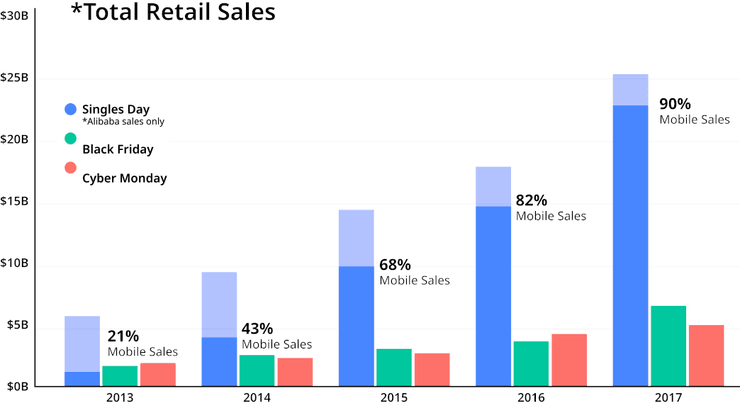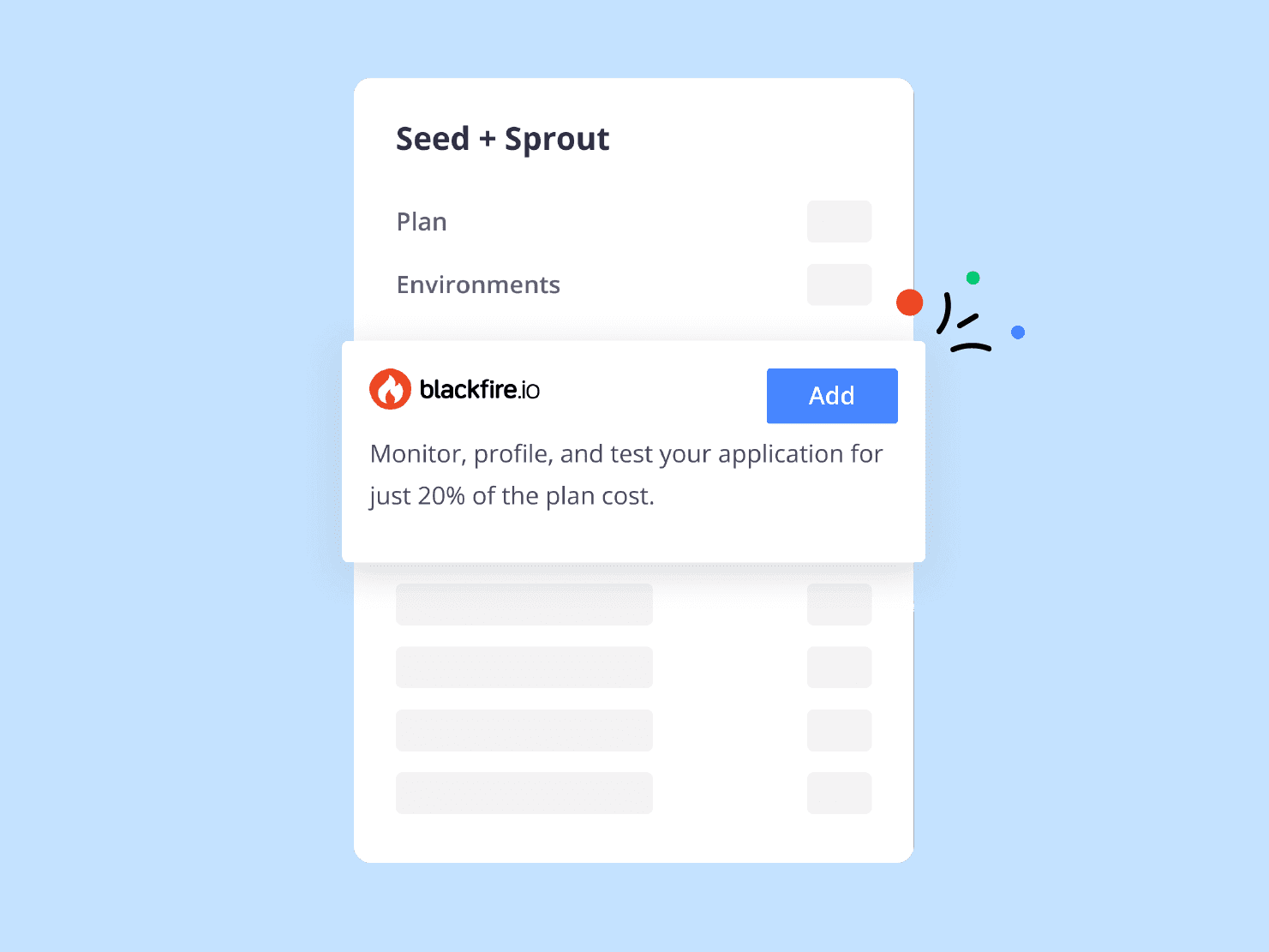Launched by Chinese tech giant, Tencent, in 2011, WeChat is the Chinese super-app you won't be able to avoid in the near future. But it's not too late to step in.
In this post, I'll explain how Chinese users surf the Internet, and introduce the most important WeChat concepts that you need to understand before taking the leap.
The future of the Internet is on mobile
I'm sure you're familiar with Black Friday, Cyber Monday, and Thanksgiving. But have you heard about Single's Day? Single's Day, which takes place on November 11 (11/11), is the unofficial Chinese holiday celebrating the pride of being single. (It's like the anti-Valentine's Day.) And it's famous for being the largest shopping day in the world.
Last year, Alibaba's marketplaces, Tmall and Taobao, made more than US$25.4 billion in sales during Single's Day. This event is now nearly four times the size of America's biggest shopping days, Black Friday and Cyber Monday. And nearly 90% of the sales happened on mobile!
Today, China's Internet population has reached 802 million people, representing about 57.7% of the entire Chinese population. More importantly, 788 million users are mobile users, accounting for 98% of the country's total user base.
In comparison, there's an estimated of 300 million Internet users in the US.
On an average day, WeChat receives approximately 30% of all the time spent in mobile apps in China (based on the 2017 Internet Trends Report).
On top of that, WeChat accounts for 90% of all messaging app users in China, while Facebook Messenger doesn't reach 30% in the US.
So yes, WeChat is huge and dominant in China, and it's coming to your door.
Quick tour of WeChat
With more than 1 billion monthly active users WeChat is the largest messaging app in China.
WeChat embeds a complete ecosystem of tools and services, enabling users to buy train and plane tickets, read news, purchase and manage city services, pay for utilities, book a doctor’s appointment, pay for traffic fines, hail a ride share, book a stay at a hotel, get a bike share, order takeout, donate to charity, pay taxes, and more.
WeChat also includes a payment system, called WeChat Pay, used by more than 800 million users worldwide, accepts 13 currencies in more than 25 countries, and is available in more than 300,000 offline stores. WeChat Pay has already replaced cash for many Chinese citizens.
Today, WeChat is mostly used in China, but it's expanding very quickly overseas. International brands that have already taken the leap are targeting Chinese consumers in mainland China, as well as Chinese tourists and expatriates consuming overseas (travel retail). Those brands build marketing campaigns or e-commerce applications on WeChat. In 2013, McDonalds paved the way as the first major overseas company to launch an e-commerce campaign on WeChat. Today, most luxury brands and retail stores have already launched WeChat campaigns, WeChat stores, and WeChat mini programs. Even Google launched its own WeChat mini program in China.
There are two WeChat networks: overseas (WeChat) and domestic (Weixin)
The most important thing to understand before getting started on WeChat is that there are two different WeChat networks.
- Weixin for the domestic audience which regroups all users registered from mainland China, Macau, Hong Kong, Taiwan, South Korea, and Japan
- WeChat for the overseas audience which regroups users from every other country.
For individual account (users), the mobile phone used to register will define the network that you belong to, whereas for official account (businesses), the location of your business entity will define which network you belong to.
While it's true that contacts are shared between both networks (a user on the domestic network can communicate with users on the overseas network and vice versa), you should know that a user registered on the domestic network won't be able to follow or join an official account on the overseas network.
This means that if you open a WeChat official account (overseas) for your brand or company, you won't have access to the audience of the domestic network. To access the domestic audience, you need a Weixin official account (domestic), which requires you to have a business entity in China.
Also, some marketing features (like advertising, tracking, reporting) are currently available only in the domestic network. However, those features are frequently deployed on the overseas network, eliminating the issue in most cases.
As more countries are added to the domestic network, the boundaries between both networks are shrinking, and more features are being rolled out on both networks.
So, opening a WeChat official account today is a very good first step into the giant WeChat ecosystem.
There are two WeChat application types: H5 site and mini program
In the past, brands were building WeChat-optimized websites (aka H5 site), which open in the WeChat browser, to run marketing campaigns, increase brand awareness, and sell products. Today, many brands are still building H5 sites as they're easy to develop and deploy using the same technologies developers use every day.
In January 2017, Tencent launched their WeChat mini programs. A WeChat mini program is a lightweight application (less than 10MB) that runs instantly on WeChat’s interface. WeChat mini programs have seen an explosive growth, and there are more than 1 million WeChat mini programs available today, with 280 million daily users. It's quite impressive knowing that it took Apple 10 years to reach 2.1 million mobile applications in its app store!
E-commerce and gaming are the most popular segments among mini programs. Many major consumer brands have already launched their own mini program, offering an incredible potential to attract customers and monetize on WeChat.
According to the Mini Program Ecosystem Evolution 2018 report from Jisu, mini programs have reached a "hyper-growth" period and are beyond the early stages of "exploration" and "market activation." Even though mini programs are on their way to ‘maturity stage,’, it's still not too late for brands to join this incredible consumption trend.
Both H5 sites and mini programs have pros and cons; your choice will depend on what you want to achieve. In either case, feel free to contact us for more details about this topic.
Deploy your WeChat application on Platform.sh
Whether you plan to build a WeChat H5 site or a WeChat mini program on the overseas network, Platform.sh is definitely the right choice.
Platform.sh has unique support for multi-applications, enabling you to develop your back end and your front end together in production-like environments. This capability makes building new features and testing backward compatibilities (APIs) extremely simple. Remember that both WeChat H5 sites and WeChat mini programs are always powered by both a back end and a front end.
Platform.sh also supports most of the web programming languages (including PHP, Ruby, Node.js, Python, Go, Java), so you can build your WeChat applications using the frameworks and tools you're already familiar with.
With instant cloning of entire development environments, Platform.sh enables you to implement fast development cycles and iterate quickly when developing and testing your applications.
Talk with you soon on WeChat!
 Switching to Platform.sh can help IT/DevOps organizations drive 219% ROI
Switching to Platform.sh can help IT/DevOps organizations drive 219% ROI Organizations, the ultimate way to manage your users and projects
Organizations, the ultimate way to manage your users and projects






